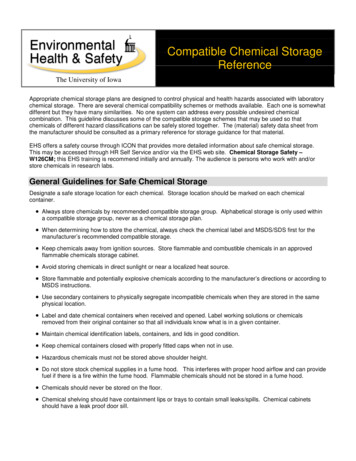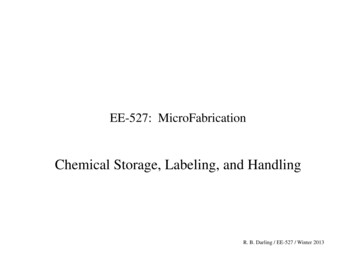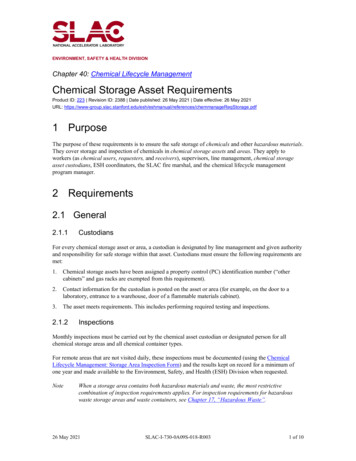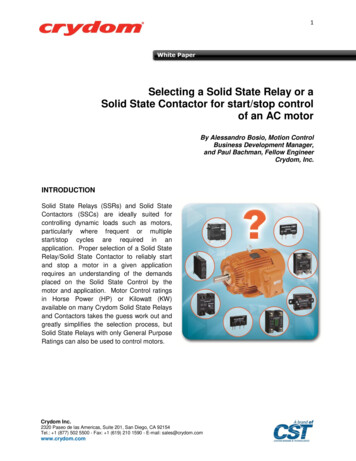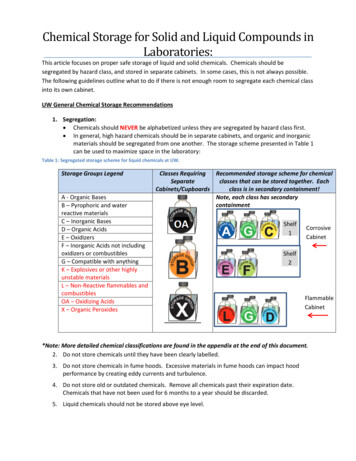
Transcription
Chemical Storage for Solid and Liquid Compounds inLaboratories:This article focuses on proper safe storage of liquid and solid chemicals. Chemicals should besegregated by hazard class, and stored in separate cabinets. In some cases, this is not always possible.The following guidelines outline what to do if there is not enough room to segregate each chemical classinto its own cabinet.UW General Chemical Storage Recommendations1. Segregation: Chemicals should NEVER be alphabetized unless they are segregated by hazard class first. In general, high hazard chemicals should be in separate cabinets, and organic and inorganicmaterials should be segregated from one another. The storage scheme presented in Table 1can be used to maximize space in the laboratory:Table 1: Segregated storage scheme for liquid chemicals at UW.Storage Groups LegendA - Organic BasesB – Pyrophoric and waterreactive materialsC – Inorganic BasesD – Organic AcidsE – OxidizersF – Inorganic Acids not includingoxidizers or combustiblesG – Compatible with anythingK – Explosives or other highlyunstable materialsL – Non-Reactive flammables andcombustiblesOA – Oxidizing AcidsX – Organic PeroxidesClasses RequiringRecommended storage scheme for chemicalSeparateclasses that can be stored together. EachCabinets/Cupboardsclass is in secondary containment!Note, each class has ammableCabinet*Note: More detailed chemical classifications are found in the appendix at the end of this document.2. Do not store chemicals until they have been clearly labelled.3. Do not store chemicals in fume hoods. Excessive materials in fume hoods can impact hoodperformance by creating eddy currents and turbulence.4. Do not store old or outdated chemicals. Remove all chemicals past their expiration date.Chemicals that have not been used for 6 months to a year should be discarded.5. Liquid chemicals should not be stored above eye level.
Liquid Chemical Classes Groups A, C, D (A - Organic Bases, C – Inorganic Bases, D – Organic Acids) Organic and inorganic bases can be kept in the same cabinet on the same shelf. Inorganic acidsshould be separated from all bases. Ideally this means a different cabinet, but if this is notpossible, on a different shelf with secondary containment. Organic acids should be stored awayfrom inorganic acids, and all bases - ideally in the flammable cabinet. Organic bases contain nitrogen, or an amino group. Some examples include - Diethylamine,Piperidine, Triethanolamine, Benzylamine, and Benzyltrimethylammonium hydroxide. Inorganic bases normally contain a hydroxide group and accept hydrogen ions from othersubstances. Their general action is the corrosion of metals and destruction of living tissue.Examples include: Sodium hydroxide, Ammonium hydroxide, Lithium hydroxide, Cesiumhydroxide. Group B – Pyrophoric and water reactive materials: Pyrophoric and water reactive materials arethose that can ignite spontaneously or react violently with air, moisture in air, oxygen, or water.Some examples of these compounds include – Sodium borohydride, Benzoyl chloride, Zinc dust,Alkyl lithium solutions such as Methyl lithium in tetrahydrofuran, Methanesulfonyl chloride, Lithium,and Aluminum hydride. These must be stored in their own cabinet. Group E – Oxidizers including Inorganic peroxides: This class of chemical is highly reactive and givesoff oxygen and other oxidizing substances. Oxidizers can intensify combustion during a fire, widenthe flammable range of a flammable gas or liquid, and can lower the flashpoint or ignitiontemperature of combustible materials. Inorganic peroxides are generally stable but may formorganic peroxides on contact with organic compounds. Groups F, and OA (F – Inorganic Acids, OA – Oxidizing Acids): Organic and inorganic acids should not be kept in the same cabinet, but should be stored ondifferent shelves. Inorganic acids should be stored on different shelves then inorganic bases,and both should have secondary containment. Acids should not be stored near cyanide or sulfide containing chemicals to prevent formation ofhydrogen cyanide or hydrogen sulfide gases Acids should not be stored near metal piping that supplies natural gas or water Inorganic acids, organic acids, and oxidizing acids should be segregated from one another Nitric acid, perchloric acid, and sulfuric acids are oxidizing acids that should be stored in theirown secondary containment and in their own designated cabinets/cupboards with secondarycontainment – meaning Nalgene trays or equivalent. They are Group OA
Group L - Flammable Liquids: Flammable liquids must be stored away from oxidizers AND oxidizing acids (nitric, chromic,sulphuric, etc ) - generally they are kept in their own flammable cabinet. Non-flammable solvents may be stored in flammable cabinets. Flammable cabinets shall be grounded and vented. If venting is not possible the vent portshould be sealed. Refrigerators used for storage of flammable compounds shall be certified for such use anddesignated as explosion proof. K – Explosives or Other Highly Unstable Materials: Some examples of these materials include –Picric Acid Dry ( 10% H2O), Nitroguanidine, Tetrazole, Urea nitrate. X – Incompatible with ALL Other Storage Groups: Some examples of this group of chemicals include-Picric Acid Moist (10% – 40% H2O), Phosphorus, Benzyl Azide, Organic Peroxides, and Sodiumhydrogen sulfide.Notes on Organic Peroxides: Organic peroxides in particular are among the most dangerous used in thelab because they are used frequently (free radical source and oxidants) and they are sensitive to shock,spark, and ignition. Certain commonly used laboratory chemicals can form peroxides upon exposure toatmospheric oxygen and in the presence of light or heat. Some of these chemicals may continually formperoxides, while others remain at a low equilibrium, only becoming dangerous if concentrated (ie.distillation or evaporation). The table below has three classes of peroxidizables Class A, Class B, andClass C:
Table 2: Definitions of the 3 classes of peroxide forming compounds. The list is not exhaustive.Class AClass BClass CDefinitionChemicals that formexplosive levels ofperoxides withoutconcentrationChemicals that formexplosive levels ofperoxides on concentrationChemicals that may autopolymerize asresult of peroxide accumulationMaximumstorage3 months12 neIsopropyl etherTetrafluoroethyleneaVinylidene chlorideAcetalAcetaldehydeBenzyl pentadieneDiethyl etherDiethylene glycol dimethylether DioxanesEthylene glycol dimethylether 4-Heptanol2-HexanolIsopropyl opentaneMethyl isobutyl dronaphthaleneVinyl ethersOther secondary alcohols Uninhibited chemicals – 24 hours Inhibited chemicals - 12 monthsAcrylic fluoroethyleneMethyl methacrylatebStyreneTetrafluoroethylenecVinyl yladiene chloridePeroxidizables Storage Requirements Label and date suspected ALL suspected peroxide formers.Peroxide-forming solvents should be purchased in limited quantities and older material in inventoryshould be preferentially selected for use.
Store at cool temperatures, but do not refrigerate. Refrigeration may cause peroxides to precipitateout.Store in original containers or using amber coloured bottles with tightly secured caps and labeledwith dates of receipt and opening. Do not use glass containers with metal screw caps or glassstoppers.Store out of direct light.If possible, add an oxidative inhibitor to decrease storage risk. If inhibitors are used, note that theydeplete over time and therefore must be checked periodically.Peroxidizables Handling Requirements Only use plastic or ceramic spatulas – no metal onesDispense quantities as needed. Do not return unused material to stock container.Periodic testing to detect peroxides should be performed and recorded on previously openedmaterial. If peroxide concentration is close to or exceeds 100 ppm, peroxides must be neutralizedthen material should be disposed of.Check peroxide forming solvents for peroxide formation prior to distillation or evaporation. Visiblecrystals, precipitate or an oily viscous layer present in the material are visual indicators of dangerousperoxide levels. Immediately contact Greg Friday at ext. 35755 or the Safety Office for disposal.Solid chemicals: Flammable solids and oxidizing salts should be segregated onto separate shelving. Examples ofoxidizing solids include: bromates, chlorates, chlorites, chromates, dichromates, hypochlorites,iodates, nitrates, nitrites, perchlorates, peroxides, permanganates, picrates.Water reactive or pyrophoric materials should be placed in their own cabinet
materials should be segregated from one another. The storage scheme presented in Table 1 can be used to maximize space in the laboratory: Table 1: Segregated storage scheme for liquid chemicals at UW. Storage Groups Legend Classes Requiring Separate Cabinets/Cupboards Recommended storage scheme for chemical classes that can be stored together.







